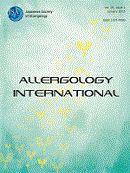60 巻, 1 号
選択された号の論文の15件中1~15を表示しています
- |<
- <
- 1
- >
- >|
REVIEW ARTICLE
-
2011 年 60 巻 1 号 p. 1-9
発行日: 2011年
公開日: 2011/03/10
PDF形式でダウンロード (550K) -
2011 年 60 巻 1 号 p. 11-15
発行日: 2011年
公開日: 2011/03/10
PDF形式でダウンロード (130K) -
2011 年 60 巻 1 号 p. 17-24
発行日: 2011年
公開日: 2011/03/10
PDF形式でダウンロード (117K) -
2011 年 60 巻 1 号 p. 25-35
発行日: 2011年
公開日: 2011/03/10
PDF形式でダウンロード (245K)
ORIGINAL ARTICLE
-
2011 年 60 巻 1 号 p. 37-43
発行日: 2011年
公開日: 2011/03/10
PDF形式でダウンロード (136K) -
2011 年 60 巻 1 号 p. 45-51
発行日: 2011年
公開日: 2011/03/10
PDF形式でダウンロード (138K) -
2011 年 60 巻 1 号 p. 53-59
発行日: 2011年
公開日: 2011/03/10
PDF形式でダウンロード (155K) -
2011 年 60 巻 1 号 p. 61-67
発行日: 2011年
公開日: 2011/03/10
PDF形式でダウンロード (256K) -
2011 年 60 巻 1 号 p. 69-77
発行日: 2011年
公開日: 2011/03/10
PDF形式でダウンロード (351K) -
2011 年 60 巻 1 号 p. 79-85
発行日: 2011年
公開日: 2011/03/10
PDF形式でダウンロード (214K) -
2011 年 60 巻 1 号 p. 87-92
発行日: 2011年
公開日: 2011/03/10
PDF形式でダウンロード (133K)
CASE REPORT
-
2011 年 60 巻 1 号 p. 93-96
発行日: 2011年
公開日: 2011/03/10
PDF形式でダウンロード (451K) -
2011 年 60 巻 1 号 p. 97-101
発行日: 2011年
公開日: 2011/03/10
PDF形式でダウンロード (88K) -
2011 年 60 巻 1 号 p. 103-108
発行日: 2011年
公開日: 2011/03/10
PDF形式でダウンロード (96K)
LETTER TO THE EDITOR
-
2011 年 60 巻 1 号 p. 109-110
発行日: 2011年
公開日: 2011/03/10
PDF形式でダウンロード (92K)
- |<
- <
- 1
- >
- >|
